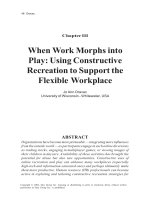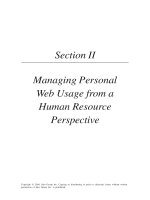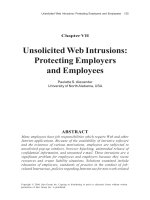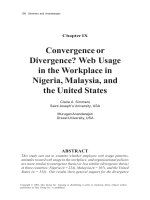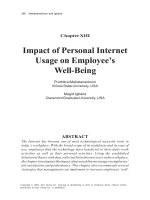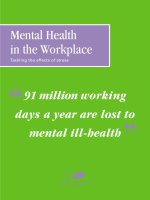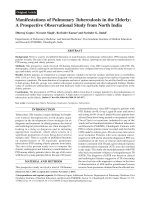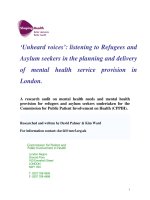Providing mental health first aid in the workplace: A Delphi consensus study
Bạn đang xem bản rút gọn của tài liệu. Xem và tải ngay bản đầy đủ của tài liệu tại đây (584.27 KB, 10 trang )
Bovopoulos et al. BMC Psychology (2016) 4:41
DOI 10.1186/s40359-016-0148-x
RESEARCH ARTICLE
Open Access
Providing mental health first aid in the
workplace: a Delphi consensus study
Nataly Bovopoulos1,2* , Anthony F. Jorm1, Kathy S. Bond2, Anthony D. LaMontagne3,4, Nicola J. Reavley1,
Claire M. Kelly2,5, Betty A. Kitchener2,5 and Angela Martin6
Abstract
Background: Mental health problems are common in the workplace, but workers affected by such problems are
not always well supported by managers and co-workers. Guidelines exist for the public on how to provide mental
health first aid, but not specifically on how to tailor one’s approach if the person of concern is a co-worker or
employee. A Delphi consensus study was carried out to develop guidelines on additional considerations required
when offering mental health first aid in a workplace context.
Methods: A systematic search of websites, books and journal articles was conducted to develop a questionnaire
with 246 items containing actions that someone may use to offer mental health first aid to a co-worker or
employee. Three panels of experts from English-speaking countries were recruited (23 consumers, 26 managers and
38 workplace mental health professionals), who independently rated the items over three rounds for inclusion in
the guidelines.
Results: The retention rate of the expert panellists across the three rounds was 61.7 %. Of the 246 items, 201 items
were agreed to be important or very important by at least 80 % of panellists. These 201 endorsed items included
actions on how to approach and offer support to a co-worker, and additional considerations where the person
assisting is a supervisor or manager, or is assisting in crisis situations such as acute distress.
Conclusions: The guidelines outline strategies for a worker to use when they are concerned about the mental
health of a co-worker or employee. They will be used to inform future tailoring of Mental Health First Aid training
when it is delivered in workplace settings and could influence organisational policies and procedures.
Keywords: Mental health first aid, Workplace, Delphi method, Workplace guidelines
Background
Depression and anxiety disorders are highly prevalent
mental illnesses and are among the leading causes of disability worldwide [1, 2]. Mental illnesses can significantly
affect workplace productivity due to absenteeism and
presenteeism (working whilst unwell and not meeting
expected standards of productivity) [3]. The majority of
full-time employees experiencing common mental illness
do not receive treatment, or delay seeking treatment
[4, 5]. The longer treatment is delayed, the more
likely a person will have a long-term sickness absence
* Correspondence:
1
Centre for Mental Health, Melbourne School of Population and Global
Health, University of Melbourne, 207 Bouverie St, Parkville, VIC 3010, Australia
2
Mental Health First Aid Australia, Level 6, 369 Royal Parade, Parkville, VIC
3052, Australia
Full list of author information is available at the end of the article
from work [6]. There is also strong evidence of a
positive relationship between the duration of depression
and the severity of work disability experienced [7].
There are a number of workplace barriers to helpseeking, including lack of recognition, stigmatising
attitudes and discrimination. For example, in a comprehensive study with 60,556 Australian workers, 31 % of
full-time workers with high psychological distress did
not recognise that they had a mental health problem
and consequently had not sought any help [4]. Addressing workers’ lack of recognition for needed help, attitudes and structural barriers can significantly decrease
work productivity losses, with the largest decrease associated with improving recognition [8]. A recent study
across 35 countries found that people with depression
had significant expected and actual experiences of
© 2016 The Author(s). Open Access This article is distributed under the terms of the Creative Commons Attribution 4.0
International License ( which permits unrestricted use, distribution, and
reproduction in any medium, provided you give appropriate credit to the original author(s) and the source, provide a link to
the Creative Commons license, and indicate if changes were made. The Creative Commons Public Domain Dedication waiver
( applies to the data made available in this article, unless otherwise stated.
Bovopoulos et al. BMC Psychology (2016) 4:41
discrimination in the workplace [9]. Concerns about being treated differently by co-workers and supervisors,
being seen as less competent and possible job loss have
been cited as barriers to disclosing a mental illness at
work [10]. Managers have been found to be more critical
of an employee’s job performance if they are seen to be
experiencing burnout or depression compared to a
physical illness like thyroid disease [11]. Poor support
from managers in turn has been found to double the
risk of long-term sickness absence related to mental
illness [12].
The impact of mental illness in the workplace could
be reduced by facilitating early intervention that encourages help-seeking and supports recovery through reasonable work accommodation [13]. A factor that can
facilitate professional help-seeking is that someone else
suggests it, such as a co-worker or manager [14, 15].
Mental Health First Aid (MHFA) training is one way
to promote early help-seeking, by equipping participants with the knowledge and skills to provide the
initial help to someone developing a mental health
problem or experiencing a mental health crisis before
appropriate professional help is found [16]. MHFA
courses have been well evaluated and consistently
demonstrate an association with improved knowledge,
decreased stigmatizing attitudes and increased helping
behaviours [17].
The MHFA curriculum is drawn from guidelines developed using the expert consensus of mental health
professionals, consumers and carer advocates from developed English-speaking countries [18–25]. Guidelines
for providing mental health first aid in particular settings
have also been developed to inform MHFA course adaptations. For example, guidelines on how to provide culturally appropriate mental health first aid to Aboriginal
and Torres Strait Islander adults and adolescents have
informed the Aboriginal and Torres Strait Islander
MHFA Course [26, 27]. Though guidelines exist on how
to help someone return to work after depression and
anxiety and how organisations can help prevent mental
illness, there are no guidelines on how to offer help in a
workplace setting that can be used to inform a course
for the workplace [28, 29].
The Standard MHFA course was developed for the
general community, akin to physical first aid, and has
been delivered and shown to be effective in workplace
settings in three randomised controlled trials in
Australia [30], Denmark [31] and Sweden [32]. However,
none of the courses evaluated in these studies aimed to
improve the helping responses specifically of workers toward their peers in the workplace. Rather, these trials focused on improving helping responses towards any
adult, suggesting that the use of a workplace sample was
more for convenience. A survey of Australian MHFA
Page 2 of 10
Instructors exploring their experiences of delivering
training to workplaces indicated a demand to further
tailor the content towards co-workers helping one another [33]. In addition, a mental health literacy intervention for university staff which included MHFA training,
recommended that future MHFA research consider
tailoring the course further and include strategies that
target work-related risk and protective factors [34]. The
additional considerations of delivering mental health
first aid in a workplace that have not been covered
within existing guidelines or curricula include the workplace relationship between the mental health first aider
and the recipient, the potential overlap and conflicts
with performance management and concerns around
workplace discrimination on the basis of mental health
status.
The aim of this study was to establish guidelines on
how someone should apply mental health first aid to a
co-worker or employee developing or experiencing a
common mental health problem (symptoms of depression, anxiety and substance use problems which may
meet criteria for a diagnosis of a mental illness). The
guidelines will be used to inform a tailored MHFA
course directed at improving workers’ helping response to
their co-workers. These guidelines are intended to complement two other workplace-related guidelines already
developed, which both used the Delphi methodology preventing common mental illnesses in workplaces [28]
and helping an employee return-to-work during recovery
from a common mental illness [29].
Methods
The Delphi expert consensus method was used. This
method establishes the consensus of expert panels on a
particular topic and is often used for the development of
guidelines [35]. As used here, the expert panellists rated
a series of statements about potential mental health first
aid actions in workplace settings, which were generated
from a comprehensive search of the literature.
Panel formation
Consumer advocates, managers and workplace mental
health professionals considered to have expert knowledge in the field of workplace mental health were recruited from five English-speaking developed countries
to participate in the study through the distribution of an
advertisement with a link to the plain language statement. See Table 1 for the inclusion criteria. The study
aimed to recruit 30 people in each panel. This panel size
is within the typical Delphi panel size of 15–60 experts
[36]. A panel size of 23 has been found to yield stable results in a simulation study [37].
Consumer advocates were recruited via consumer advocacy groups and organisations focused on mental health.
Bovopoulos et al. BMC Psychology (2016) 4:41
Page 3 of 10
Table 1 Inclusion criteria
Literature search and questionnaire development
Panel
Criteria
Consumer
Be 18 years or older, AND
Live in Australia, Canada, Ireland, New Zealand,
United Kingdom or the United States, AND
Have lived experience of mental health problems
whilst working, AND
Have experience in an advocacy role, AND
Symptoms of mental health problems are currently
well managed.
Manager
Be 18 years or older, AND
Live in Australia, Canada, Ireland, New Zealand,
United Kingdom or the United States, AND
Have a minimum of 5 years’ management
experience, AND
Training in mental health, OR
Practical experience in supervising employees with
mental health problems.
A comprehensive literature search, using key terms, was
conducted of websites, journal articles, books, booklets
and training manuals. This search aimed to find relevant
statements on how a worker can provide mental health
first aid to a co-worker or employee developing early
signs or symptoms of a common mental illness.
The key search terms used were (work* OR manager
OR staff OR employee OR employer) AND (mental
health OR mental illness OR mental disorder OR
depression OR anxiety OR substance use OR alcohol
OR drug OR distress OR stress) AND (first aid OR help
OR assistance OR support OR early intervention). See
Table 2 for details.
These search terms were used to find relevant Englishlanguage websites, books and journal articles. Relevant
websites were found via google.com.au, google.com,
google.com.ca and google.com.uk. The first 50 hits
were retrieved and those that appeared relevant were
reviewed by the researcher in order to find helping
statements. Relevant books were searched via books.google.com.au and amazon.com. The first 50 hits
were reviewed from the top selling books. Relevant
journal articles published in the last 10 years (2003–
2013) were found via PsycInfo and PubMed databases,
searching via title or abstract.
The statements identified by the first author were then
categorised thematically in a spreadsheet and distilled
into statements that were instructional, unambiguous
and contained one idea per statement. A total of 310 resources were used to develop the Round 1 survey (see
Table 2).
Workplace Mental Be 18 years or older, AND
Health Professional Live in Australia, Canada, Ireland, New Zealand,
United Kingdom or the United States, AND
Have a minimum of 5 years’ experience in their
profession, AND
Clinical, policy, program and/or research experience
regarding mental health issues in the workplace.
Managers were recruited through employer representative
organisations (e.g. Chambers of Commerce) and workplace mental health groups (e.g. the HeadsUp Australian
campaign LinkedIn group). Workplace mental health professionals were recruited through direct contact with the
primary author. The study did not aim to obtain representative samples of experts, as the Delphi method aims to
find panel members who can draw on a diverse range of
relevant expertise [35].
Table 2 Search strategies and results
Search source
Search terms
Search results
Examples
www.google.com.au www.google.co.uk (Work* OR manager OR staff OR employee 266 websites
www.google.ca www.google.com
OR employer) AND (mental health OR
mental illness OR mental disorder OR
depression OR anxiety OR substance use
OR alcohol OR drug OR distress OR stress)
AND (first aid OR help OR assistance OR
support OR early intervention)
/>9927/EN149_NCETA%20Booklet%2012006.pdf
www.headsup.org.au/supporting-others-in-theworkplace/having-a-conversation
books.google.com amazon.com
(Work* OR manager OR staff OR employee 9 Books
OR employer) AND (mental health OR
mental illness OR mental disorder OR
depression OR anxiety OR substance use
OR alcohol OR drug OR distress OR stress)
AND (first aid OR help OR assistance OR
support OR early intervention)
Eyers & Parker [45]
PsychInfo PubMed
(Work* OR manager OR staff OR employee 35 Journal Articles Joyce [43]
OR employer) AND (mental health OR
Moll [44]
mental illness OR mental disorder OR
depression OR anxiety OR substance use
OR alcohol OR drug OR distress OR stress)
AND (first aid OR help OR assistance OR
support OR early intervention) in the
abstract or text of the article.
*Use a wildcard search in order to include terms such as workplace or worker
Bovopoulos et al. BMC Psychology (2016) 4:41
In consultation with a working group consisting of four
staff from Mental Health First Aid Australia, and three
workplace mental health researchers from the University
of Melbourne and Deakin University (the authors of this
paper), the statements were reworded for consistency and
to avoid repetition, whilst remaining true to the meaning
of the original text. The working group of researchers met
on several occasions to finalise the statements, which
resulted in the Round 1 questionnaire organised thematically into 11 sections: General Awareness, Training,
Approach, Communication, Performance, Follow-up,
Distress, Support, Reasonable Adjustments, Disclosure
and Substance Use Problems and Intoxication. In total,
the working group met for more than 60 h to finalise the
survey, process feedback and draft the guidelines. See
Additional file 1: for a copy of the surveys.
Page 4 of 10
ideas that had not been included in the Round 1 survey
and were within the scope of the project. The Round 2
survey also included items from Round 1 that needed
re-rating. Prior to being sent the survey, participants
were emailed a report with a summary of the ratings of
each panel for items to be re-rated, along with a list of
items that were endorsed and rejected. This allowed participants to compare their ratings against each panel’s
rating and consider whether they wished to change or
keep their answer the same in the next round [35].
Rounds 2 and 3 did not provide an opportunity for
further comments. If a re-rated item was not rated as
‘essential’ or ‘important’ by 80 % or more of each panel,
it was rejected. Statements that met criteria for a re-rate
in Round 2 were included in the final Round 3 survey.
Participants were emailed four reminders to complete
the survey over a 4-week period in each Round.
Data collection and analysis
Data was collected in three survey rounds administered
online using SurveyMonkey between August 2015 and
February 2016. Participants were invited to complete the
Round 1 questionnaire, which asked them to rate
whether certain actions should be included in guidelines
on how a worker or manager should provide mental
health first aid to a co-worker or an employee. Panellists rated each action to indicate its importance in
being included in the guidelines on the following 5point scale: ‘essential’, ‘important’, ‘don’t know/depends’,
‘unimportant’ or ‘should not be included’. During Round
1, participants were able to submit additional comments
or suggestions to be included as actions to be rated by the
panellists in the Round 2 survey. The qualitative data were
collected by asking in each survey section, “Do you have
any additional statements that you would like to add in
this section? Please write your suggestions in the box
provided.”
After panel members completed a survey round, the
data was analysed using a spreadsheet to calculate the
endorsement percentages by participants for each statement. The statements were categorised as follows:
1. Endorsed. The item received an ‘essential’ or
‘important’ rating from 80–100 % of each panel.
2. Re-rate. The item received an ‘essential’ or
‘important’ rating from 70–79 % of each panel, or
an ‘essential’ or ‘important’ rating from 70–79 %
of members from at least one panel and above
80 % from the other panels.
3. Rejected. The item did not fall into either the
endorsed or re-rate categories.
The working group thematically analysed participants’
comments and translated these into new actionable
helping statements for the Round 2 survey if they were
Guidelines formation
The statements that reached the consensus criterion
were written into connected sentences and edited by the
working group. The final draft was shown to participants
to obtain feedback on style and clarity. Comments
received were used to finalise the wording of the
guidelines.
Ethics
The Human Research Ethics Committee of the University
of Melbourne approved the research in July 2015. Informed consent was obtained from all participants by
clicking ‘yes’ to a question about informed consent in the
Round 1 survey.
Results
A total of 141 experts were recruited, with 89 completing all three rounds - 23 consumers, 26 managers
and 38 workplace mental health professionals. The retention rate for completing all three rounds was
61.7 % (see Table 3 for a breakdown according to
panel type). Participants who completed all three
rounds were 79.3 % female, 19.6 % male and 1.1 %
identified as transsexual female. They were on average
47.5 years of age (10.3 SD, range 23 – 70) and were
from Australia (93.1 %), the United States (3.6 %),
Table 3 Retention rate
Expert panel
Round 1 Round 2 Round 3 Retention rate
Consumers
43
27
23
53.4 %
Managers
35
28
26
74.3 %
Workplace Mental Health 63
Professionals
43
38
60.3 %
Total
98
87
61.7 %
141
Bovopoulos et al. BMC Psychology (2016) 4:41
Page 5 of 10
Canada (1.1 %), New Zealand (1.1 %) and the United
Kingdom (1.1 %). Of the 23 consumers, there were 4
managers, 3 consumer consultants/advocates, 3 policy
officers/advisors, 2 nurses, 2 students, 2 academics, 2
administrators, 1 teacher, 1 consultant, 1 patient services assistant, 1 self-employed person, 1 retired
mental health professional, 1 person on a disability
support pension and 2 who did not specify their employment status or occupation. Of the 38 workplace
mental health professionals, there were 11 workplace
health and safety professionals, 9 trainers, 4 psychologists,
4 social workers, 3 workplace mental health program
managers, 2 researchers, 2 nurses, 1 Employee Assistance
Program Co-ordinator, 1 mental health advisor, and 1
manager.
Item ratings
A total of 363 items were rated over 3 rounds, which resulted in 201 endorsed items and 162 rejected items.
Figure 1 illustrates the total number of items endorsed,
re-rated and rejected over the three rounds (also see
Additional file 2: for a list of the endorsed and rejected
items). Overall, ratings of whether items should be
included in the guidelines were similar across the
consumer, manager and professional panels, with correlations for item endorsement rates of 0.88 between consumers and managers, 0.86 between consumers and
workplace mental health professionals and 0.92 between
managers and workplace mental health professionals.
The endorsed items outline what a co-worker and
manager should do to help a co-worker showing signs of
Round 1
Questionnaire
(246 items)
Items to be
included
(n=132)
Items to be rerated
(n=33)
New items to be
added
(n=117)
Items to be
excluded
(n=81)
Round 2
Questionnaire
(150 items)
Items to be
included
(n =52)
Items to be rerated
(n=33)
Items to be
excluded
(n=65)
Round 3
Questionnaire
(33 items)
Items to be
included
(n=17)
Items to be
excluded
(n=16)
Total number of Items to
be included
(n=201 )
Fig. 1 Total number of items endorsed, re-rated and rejected
Bovopoulos et al. BMC Psychology (2016) 4:41
Page 6 of 10
a mental health problem or experiencing a mental health
crisis. They include knowing the signs and symptoms of
a mental health problem at work and how work contributes to mental health problems. The guidelines outline
specific actions for how to approach and talk with the
person in a caring and non-judgmental way. They also
provide guidance for how a person’s manager would
offer mental health first aid, such as when reasonable adjustments or performance management are also required. Strategies for managing crisis situations, like
acute distress and intoxication in the workplace, are also
covered. See Table 4 for a summary of the number of
items presented in each theme and the number of items
endorsed.
As expected, there were some differences between
groups. Items that were endorsed or rejected by one
group only and received a notably higher or lower rating
(±10 %) by this group are noted below. Though there is
no set cut-off in Delphi studies, the cut-off is consistent
with similar studies [28, 29, 35] and is greater than a
small effect size [38].
Comparison between consumers and other groups
There were two items that received lower ratings from
consumers compared to managers and workplace mental
health professionals. These were: ‘the manager should
inform the person of the appropriate use of sick leave
entitlements’ and ‘the helper should not organise a team
meeting to confront the person, even if all other attempts to help the person who is misusing substances
fail.’
There were six items that received higher ratings from
consumers compared to managers and workplace mental
health professionals that generally fit into the following
themes: approaching someone in a more senior role;
communicating non-judgementally, non-verbally and
verbally; talking to others; and giving support and
information.
Comparison between managers and other groups
There were no items rated lower by managers compared
to the other groups and there was only one item that received a higher rating from managers compared to consumers and workplace mental health professionals. This
item was: ‘if after following up with the manager the
concerns are still not addressed satisfactorily, the helper
should raise their concerns with the health and safety
manager or representative’.
Comparison between workplace mental health
professionals and other groups
There were six items that received lower ratings from
workplace mental health professionals compared to consumers and managers that generally fit into the following themes: confidentiality; approaching the person; and
giving support and information.
Guidelines development
The endorsed items formed the basis of guidelines for
providing mental health first aid to a co-worker and are
available to download from www.mhfa.com.au. See
Additional file 3: for a copy of the guidelines.
Discussion
This study used the Delphi method to develop guidelines
on how to offer mental health first aid to a co-worker.
Table 4 Themes and sub-themes of the guidelines
Themes
Sub-themes
Number of
items
Number of
endorsed items
General Awareness
6
6
Signs and symptoms of mental health problems
in the workplace
4
3
Making the approach
Deciding whether to approach
If the person’s behavior is affecting others or posing a
risk to health and safety
Planning your approach
Additional considerations if you are the person’s manager
78
30
Listening and communicating non-judgmentally
Confidentiality
Building trust
When talking with the person
Don’ts
What if I’m not the right person to help
What if they don’t want to talk?
Additional considerations if you are the person’s manager
116
74
Giving support and information
Additional considerations if you are the person’s manager
100
49
22
18
28
13
Helping the distressed co-worker
Helping the intoxicated co-worker
Additional considerations if you are the person’s manager
Bovopoulos et al. BMC Psychology (2016) 4:41
Overall, 201 actions were endorsed from a range of options. Table 4 presents the main themes and sub-themes
of the guidelines. The endorsed actions were written into
a guidelines document which organisations can freely access to help inform their training, policies and practice.
The guidelines provide instruction on when and how to
approach a co-worker who may be experiencing a
mental health problem or crisis, listening and communicating non-judgmentally, providing support and information, and how to respond in crisis situations. There
are additional strategies to consider if the first aider is
also the person’s manager.
The aim of this study was to complement the content
in the existing guidelines by developing guidelines on
how to tailor mental health first aid when it is provided
in a workplace setting. There are already guidelines
about how to offer assistance to someone who may be
experiencing a range of mental health problems and crises [18–25]. However, some duplication of content did
occur, for example with items around choosing a time
and place to approach a person or building trust and listening non-judgmentally [23]. A challenge previously
noted with developing guidelines for workplaces is making them specific enough to be useful, while still being
broad enough to be applicable across various industries
and types of workplaces [28]. There are some items that
refer to services such as an Employer Assistance
Program and Human Resources. These items may not be
applicable for smaller businesses or organisations [39].
Of the seven themes covered by the Delphi items,
there were three themes that generated many differences
of opinion and commentary from the panellists. Firstly,
the panellists often commented on the need for a clear
delineation between when a person is carrying out the
first aider role versus any other roles they may carry out
in the organisation, e.g. they are the person’s manager.
In the feedback received, many participants indicated
that the applicability of some of the items varied depending on the workplace hierarchical relationship between the first aider and the recipient of the first aid.
These comments led to the working group developing a
number of items for the Round 2 survey that specified
that the first aider is the person’s manager, this removed
ambiguity and led to many of the revised items being
endorsed. For example, the following items were endorsed when reworded to be acted on by the person’s
manager: ‘After raising their concerns with the person,
the MANAGER should ask if the person would like to
continue the conversation in the presence of a support
person, e.g. an external advocate, co-worker’ and ‘the
MANAGER should be aware of any legal obligations
that the person has to disclose that they have a mental
health problem at work, e.g. medical practitioners may
be required to report medical conditions that impair
Page 7 of 10
their performance.’ Role delineation was also a theme in
differences found between groups. Items that were
rejected by the workplace mental health professionals
panel, such as asking how long the person has been experiencing a mental health problem, may have been
rejected because they were seen to be more appropriate
to be carried out by a mental health professional or an
Employee Assistance Program provider.
The second theme that raised a lot of commentary
amongst participants was in relation to privacy, both in
the between panel differences, such as those rejected by
the workplace mental health professionals, and in the
items rejected by all panels. Breaking confidentiality was
only endorsed when the health and safety of the person
or other co-workers is at risk. The panellists rejected
items related to breaking confidentiality if the person no
longer fulfils the inherent requirements of the role or is
risking the reputation of the workplace due to their
mental health problems. Also, only two items were endorsed out of a possible eleven items on the theme of
documentation, with the use of documentation only
deemed appropriate when a worker is posing a risk to
the health and safety of others, or if the person assisting
is the worker’s manager.
With these findings in mind, if the workplace culture
is unsupportive of workers with a mental illness, it could
be quite risky to share concerns or information about a
worker to a third party within an organisation. For
example, one participant provided specific comment on
the importance of raising issues directly with the person
only: “Confidentiality is a big concern here. Most
employees experiencing a mental health issue do not
want [it] to be discussed with others. It would have to be
quite serious for me to involve other colleagues etc.” Participants commented that when a person is providing
mental health first aid to a co-worker, their primary
concern should be for the person rather than the organisation. Thus, is it understandable that many items regarding the boundaries of confidentiality and the needs
for documentation were rejected, because of the risk of
how the information may be used. As another participant commented:
“It’s difficult to answer really because a lot relies
upon the culture that exists in the workplace. The
last thing we would want is for people to ‘use’ this
information to their advantage, e.g. if there’s a high
level of competition that exists in the workplace.
The motives need to be pure as the goal should
always be to encourage people to access the help
and support they need. The less people involved in
that process the better in my view to respect a
person’s privacy. If seeking advice not revealing the
person’s name etc. is of utmost importance.”
Bovopoulos et al. BMC Psychology (2016) 4:41
Finally, a theme that panellists found difficulty in
reaching any consensus on concerned items that would
provide guidance on what to do if the first aider did not
feel comfortable to approach a person in a more senior
position. Out of a possible eight actions, the only one
endorsed was to seek advice from the Employee
Assistance Program on what to do, whereas seeking
assistance from other resources such as a co-worker
at the same level as the person, the person’s manager
or Human Resources were rejected. This finding
draws attention to the complexity risks and potential
conflicts of interest involved in helping people at different levels in the workplace hierarchy.
The guidelines may be compared to other workplace
guidelines, including psychological health and safety standards developed in Canada, and prevention and return-towork guidelines developed in Australia [28, 29, 40]. The
focus and scope of these other workplace guidelines are
quite different, in that they focus more on actions that can
be taken by the organisation rather than an individual
worker, and across a variety of areas rather than on the
narrow area of mental health first aid. The guidelines can
also be compared to other mental health first aid guidelines, such as those developed for helping someone with
depression [23]. The current guidelines are complementary in that they cover additional things a co-worker
should consider in relation to their role relative to the person requiring mental health first aid, supports the person
can access within the workplace, and how to address helpseeking barriers in the workplace.
The study had a number of strengths. Three panels
were used with diverse sources of expertise, which is a
desirable feature in Delphi studies [35]. The panel types,
consumers, managers and workplace mental health
professionals, were also similar to those used in other
workplace mental health Delphi studies [28, 29]. Also
panellists were recruited from several English-speaking
countries, which increases the generalisability of findings. A limitation was the dropout rate of panel members from 141 in the first round to 98 in the second,
particularly within the consumer panel, which may have
been due to survey fatigue, as the first Round survey
took approximately 1 h to complete. However, the final
size of each panel conformed to that recommended for
Delphi studies [36]. Although the study aimed to recruit
panellists from a number of English-speaking developed
countries, the majority of participants were from
Australia. However, it is more important that participants in Delphi study have diverse expertise rather than
be representative [35]. Finally, several participants in the
first survey round questioned whether the first aider was
in an informal or formal role within the workplace. Although information was provided at the beginning of the
survey explaining that the first aider was not necessarily
Page 8 of 10
in a formal role such as a ‘Mental Health First Aid
Officer’, some participants may have completed the survey with this role in mind.
There were three main advantages of using the Delphi
method for this study: firstly it is an appropriate methodology to use when other research evidence is unavailable
on a topic; secondly expert consensus is a way of tapping
into practice-based evidence, drawing on both professional and lived-experience expertise; and thirdly it can
help answer a question that is not feasibly answered via
other methodologies such as randomised controlled trials
[35]. The chief disadvantage of using the Delphi method is
that it does not provide any evidence on the effects of applying the strategies in the guidelines.
Conclusions
Workers may be more comfortable to disclose a mental
health problem if they and their co-workers have the
confidence and skills in how to provide mental health
first aid. Using the consensus of people with lived experience of mental health problems whilst working,
managers and workplace mental health professionals,
clear strategies have been identified on how to offer
mental health first aid to someone at work. These guidelines can now be used to help inform future Mental
Health First Aid training programs, and influence organisational policies and procedures. These guidelines add
to a growing set of best practice guidelines and other resources that are being developed [28, 29, 41]. These
guidelines and resources support workplace mental
health programs that address mental health problems at
work regardless of cause, prevent the adverse impacts of
work on mental health, and promote the positive aspects
of work on mental wellbeing [42]. These guidelines will
assist workers affected by mental health problems by
enhancing early recognition, early help-seeking and consequently enhancing the provision of timely and appropriate support which may in turn limit the possible
impact mental health problems may have on their working life. Though the guidelines are aimed at individual
workers better supporting one another, if employers encourage the training of these skills across an entire
workplace, there could be productivity benefits for the
workplace as a whole.
Additional files
Additional file 1: Copies of the Round 1, 2 and 3 surveys. (PDF 1272 kb)
Additional file 2: Endorsed and rejected items including the survey
round that they were endorsed or rejected. (XLSX 166 kb)
Additional file 3: Final guidelines document. (PDF 1277 kb)
Abbreviation
MHFA, mental health first aid
Bovopoulos et al. BMC Psychology (2016) 4:41
Page 9 of 10
Acknowledgements
There are no acknowledgements.
6.
Funding
There is no funding attached to this study.
7.
Availability of data and materials
Three additional files are attached: the surveys utilised to collect data, the
endorsed and rejected items from the survey and the finalised guidelines.
Authors’ contributions
NB co-designed the study, carried out the literature search, drafted and
developed the questionnaire, recruited participants, analysed data, and
drafted and edited the manuscript. AFJ co-designed the study, carried out
questionnaire development, analysed data and edited the manuscript. KSB
carried out the literature search, drafted and developed the questionnaire,
analysed data and edited the manuscript. ADL co-designed the study, carried
out questionnaire development, analysed data and edited the manuscript.
NJR carried out questionnaire development, analysed data and edited the
manuscript. CMK carried out questionnaire development and analysed data.
BAK carried out questionnaire development, analysed data and edited the
manuscript. AM co-designed the study and edited the manuscript.
8.
9.
10.
11.
12.
Competing interests
The authors declare that they have no competing interests.
Consent for publication
The manuscript does not contain any individual persons data.
Ethics approval and consent to participate
The Human Research Ethics Committee of the University of Melbourne
approved the research in July 2015. Informed consent was obtained from all
participants by clicking ‘yes’ to a question about informed consent in the
Round 1 survey.
Author details
1
Centre for Mental Health, Melbourne School of Population and Global
Health, University of Melbourne, 207 Bouverie St, Parkville, VIC 3010, Australia.
2
Mental Health First Aid Australia, Level 6, 369 Royal Parade, Parkville, VIC
3052, Australia. 3Centre for Population Health Research, School of Health &
Social Development, Deakin University, Geelong, VIC 3220, Australia. 4Centre
for Health Equity, Melbourne School of Population & Global Health,
University of Melbourne, Level 207 Bouverie St, Parkville, VIC 3010, Australia.
5
School of Psychology, Deakin University, 1 Gheringhap St, Geelong, VIC
3220, Australia. 6Tasmanian School of Business and Economics, University of
Tasmania, Private Bag 84, Hobart, TAS 7001, Australia.
13.
14.
15.
16.
17.
18.
19.
20.
Received: 3 April 2016 Accepted: 27 July 2016
21.
References
1. Kessler RC, Angermeyer M, Anthony JC, De Graaf R, Demyttenaere K,
Gasquet I, De Girolamo G, Gluzman S, Gureje OYE, Haro JM, et al. Lifetime
prevalence and age-of-onset distributions of mental disorders in the World
Health Organization’s World Mental Health Survey Initiative. World Psychiatry.
2007;6(3):168–76.
2. Whiteford HA, Degenhardt L, Rehm J, Baxter AJ, Ferrari AJ, Erskine HE,
Charlson FJ, Norman RE, Flaxman AD, Johns N. Global burden of disease
attributable to mental and substance use disorders: findings from the
Global Burden of Disease Study 2010. Lancet. 2013;382(9904):1575–86.
3. Rd G, Tuithof M, Dorsselaer S, Have MT. Comparing the effects on work
performance of mental and physical disorders. Soc Psychiatry Psychiatr
Epidemiol. 2012;47(11):1873–83.
4. Hilton MF, Whiteford HA, Sheridan JS, Cleary CM, Chant DC, Wang PS,
Kessler RC. The prevalence of psychological distress in employees and
associated occupational risk factors. J Occup Environ Med. 2008;50(7):746–57.
5. LaMontagne AD, Sanderson K, Cocker FBA. Estimating the economic
benefits of eliminating job strain as a risk factor for depression. Occup
Environ Med. 2011;68 Suppl 1:A3.
22.
23.
24.
25.
26.
27.
Brouwers EP, Terluin B, Tiemens BG, Verhaak PF. Predicting return to work in
employees sick-listed due to minor mental disorders. J Occup Rehabil.
2009;19(4):323.
Lagerveld SE, Bültmann U, Franche RL, van Dijk FJH, Vlasveld MC,
van der Feltz-Cornelis CM, Bruinvels DJ, Huijs JJJM, Blonk RWB,
van der Klink JJL, et al. Factors associated with work participation and
work functioning in depressed workers: A systematic review. J Occup
Rehabil. 2010;20(3):275–92.
Dewa CS, Hoch JS. Barriers to Mental Health Service Use Among
Workers With Depression and Work Productivity. J Occup Environ Med.
2015;57(7):726–31.
Brouwers EP, Mathijssen J, Van Bortel T, Knifton L, Wahlbeck K,
Van Audenhove C, Kadri N, Chang C, Goud BR, Ballester D, et al.
Discrimination in the workplace, reported by people with major
depressive disorder: a cross-sectional study in 35 countries. BMJ Open.
2016;6(2):e009961.
Brohan E, Henderson C, Wheat K, Malcolm E, Clement S, Barley EA, Slade M,
Thornicroft G. Systematic review of beliefs, behaviours and influencing
factors associated with disclosure of a mental health problem in the
workplace. BMC Psychiatry. 2012;12:11.
Mendel R, Kissling W, Reichhart T, Bühner M, Hamann J. Managers’ reactions
towards employees’ disclosure of psychiatric or somatic diagnoses.
Epidemiol Psychiatr Sci 2014:24(2):1–4
Foss L, Gravseth HM, Kristensen P, Claussen B, Mehlum IS, Skyberg K. Risk
factors for long-term absence due to psychiatric sickness: a register-based
5-year follow-up from the Oslo health study. J Occup Environ Med.
2010;52(7):698–705.
Martin A, Fisher CD. Understanding and improving managers’ responses to
employee depression. Ind Organ Psychol. 2014;7(2):270–4.
Vogel DL, Wade NG, Wester SR, Larson L, Hackler AH. Seeking help from a
mental health professional: The influence of one’s social network. J Clin
Psychol. 2007;63(3):233–45.
Athanasiades C, Winthrop A, Gough B. Factors affecting self-referral to
counselling services in the workplace: a qualitative study. Br J Guid Couns.
2008;36(3):257–76.
Kitchener BA, Jorm AF. Mental health first aid training for the public:
evaluation of effects on knowledge, attitudes and helping behavior. BMC
Psychiatry. 2002;2:10.
Hadlaczky G, Hokby S, Mkrtchian A, Carli V, Wasserman D. Mental
Health First Aid is an effective public health intervention for improving
knowledge, attitudes, and behavior. A meta-analysis. Int Rev Psychiatry.
2014;26(4):467–75.
Kelly CM, Jorm AF, Kitchener BA. Development of mental health first aid
guidelines on how a member of the public can support a person affected
by a traumatic event: a Delphi study. BMC Psychiatry. 2010;10:49.
Kelly CM, Jorm AF, Kitchener BA. Development of mental health first aid
guidelines for panic attacks: a Delphi study. BMC Psychiatry. 2009;9:49.
Kingston AH, Jorm AF, Kitchener BA, Hides L, Kelly CM, Morgan AJ, Hart LM,
Lubman DI. Helping someone with problem drinking: mental health first aid
guidelines - a Delphi expert consensus study. BMC Psychiatry. 2009;9:79.
Kingston AH, Morgan AJ, Jorm AF, Hal K, Hart LM, Kelly CM, Lubman DI.
Helping someone with problem drug use: A delphi consensus study of
consumers, carers, and clinicians. BMC Psychiatry. 2011;11.
Langlands RL, Jorm AF, Kelly CM, Kitchener BA. First aid recommendations
for psychosis: using the Delphi method to gain consensus between mental
health consumers, carers, and clinicians. Schizophr Bull. 2008;34(3):435–43.
Langlands RL, Jorm AF, Kelly CM, Kitchener BA. First aid for depression: a
Delphi consensus study with consumers, carers and clinicians. J Affect
Disord. 2008;105(1–3):157–65.
Ross AM, Kelly CM, Jorm AF. Re-development of mental health first aid
guidelines for non-suicidal self-injury: a Delphi study. BMC Psychiatry.
2014;14(1):1–8.
Ross AM, Kelly CM, Jorm AF. Re-development of mental health first aid
guidelines for suicidal ideation and behaviour: a Delphi study. BMC
Psychiatry. 2014;14(1):1–11.
Hart LM, Jorm AF, Kanowski LG, Kelly CM, Langlands RL. Mental health first
aid for Indigenous Australians: using Delphi consensus studies to develop
guidelines for culturally appropriate responses to mental health problems.
BMC Psychiatry. 2009;9:47.
Chalmers KJ, Bond KS, Jorm AF, Kelly CK, Kitchener BA, Williams-Tchen A.
Providing culturally appropriate mental health first aid to an Aboriginal or
Bovopoulos et al. BMC Psychology (2016) 4:41
28.
29.
30.
31.
32.
33.
34.
35.
36.
37.
38.
39.
40.
41.
42.
43.
44.
45.
Page 10 of 10
Torres Strait Islander adolescent: development of expert consensus
guidelines. Int J Ment Health Syst. 2014;8(1):6.
Reavley NJ, Ross AM, Martin A, LaMontagne AD, Jorm AF. Development of
guidelines for workplace prevention of mental health problems: A Delphi
consensus study with Australian professionals and employees. Ment Health
Prev. 2014;2(102):26–34.
Reavley NJ, Ross A, Killackey EJ, Jorm AF. Development of guidelines to
assist organisations to support employees returning to work after an
episode of anxiety, depression or a related disorder: a Delphi consensus
study with Australian professionals and consumers. BMC Psychiatry.
2012;12(1):135.
Kitchener BA, Jorm AF. Mental health first aid training in a workplace
setting: a randomized controlled trial. BMC Psychiatry. 2004;4:23.
Jensen KB, Morthorst BR, Vendsborg PB, Hjorthoj CR, Nordentoft M. The
effect of the mental health first-aid training course offered employees in
Denmark: study protocol for a randomized waitlist-controlled superiority
trial mixed with a qualitative study. BMC Psychiatry. 2015;15:80.
Svensson B, Hansson L, Stjernswärd S. Experiences of a Mental Health First
Aid Training Program in Sweden: A Descriptive Qualitative Study.
Community Ment Health J. 2015;51(4):497–503.
Bovopoulos NE, LaMontagne AD, Martin A, Jorm AF. Delivering Mental Health
First Aid training in Australian workplaces: Exploring Instructors’ experiences.
International Journal of Mental Health Promotion 2016;18(2):65–82.
Reavley NJ, McCann TV, Cvetkovski S, Jorm AF. A multifaceted intervention
to improve mental health literacy in employees of a multi-campus
university: a cluster randomised trial. J Public Ment Health. 2014;13(1):25–39.
Jorm AF. Using the Delphi expert consensus method in mental health
research. Aust N Z J Psychiatry. 2015;49(10):887–97.
Hasson F, Keeney S, McKenna H. Research guidelines for the Delphi survey
technique. J Adv Nurs. 2000;32(4):1008–15.
Akins RB, Tolson H, Cole BR. Stability of response characteristics of a Delphi
panel: application of bootstrap data expansion. BMC Med Res Methodol.
2005;5:37.
Rosenthal JA. Qualitative descriptors of strength of association and effect
size. J Soc Serv Res. 1996;21(4):37–59.
Martin A, Sanderson K, Scott J, Brough P. Promoting mental health in smallmedium enterprises: An evaluation of the “Business in Mind” program. BMC
Public Health. 2009;9:239.
Canadian Standards Association. Psychological health and safety in the
workplace – Prevention, promotion, and guidance to staged implementation.
2013. Retrieved 15/06/2016, from />z10032013/
LaMontagne AD, Keegel T. Reducing stress in the workplace: an evidence
review, full report. Melbourne: Victorian Health Promotion Foundation
(VicHealth); 2012.
LaMontagne AD, Martin A, Page K, Reavley NJ, Noblet AJ, Milner A, Keegel T,
Smith PM. Workplace mental health: Developing an integrated intervention
approach. BMC Psychiatry. 2014;14:131.
Joyce J. Facing the challenge of mental ill health in the workplace. J Public
Ment Health. 2013;12(2):93–7.
Moll S. The web of silence: a qualitative case study of early intervention and
support for healthcare workers with mental ill-health. BMC Public Health.
2014;14(1):138.
Eyers K, Parker G. Tackling Depression at Work: A Practical Guide
forEmployees and Managers: Allen & Unwin, Crows Nest, NSW. 2010.
Submit your next manuscript to BioMed Central
and we will help you at every step:
• We accept pre-submission inquiries
• Our selector tool helps you to find the most relevant journal
• We provide round the clock customer support
• Convenient online submission
• Thorough peer review
• Inclusion in PubMed and all major indexing services
• Maximum visibility for your research
Submit your manuscript at
www.biomedcentral.com/submit

